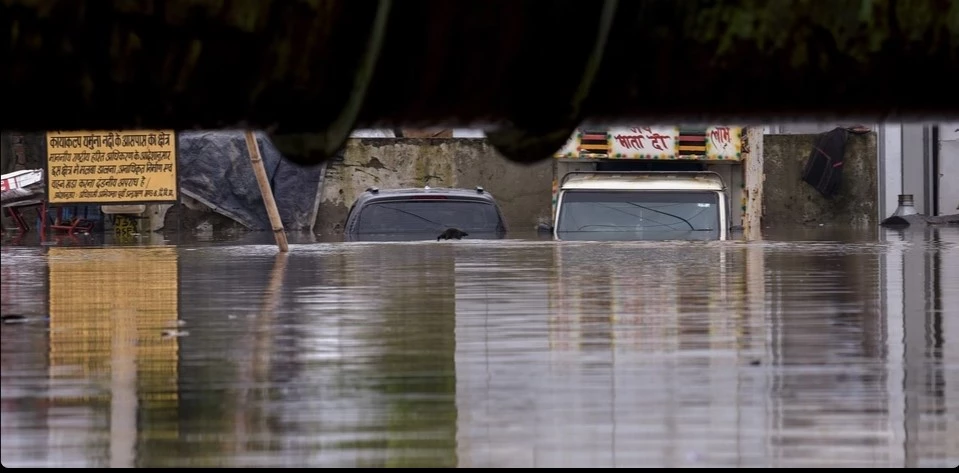Mass evacuation as floodwater enters Delhi

Stay tuned with 24 News HD Android App

Hundreds of residents have been evacuated in the Indian capital Delhi as the floodwater from swollen Yamuna River entered the city.
The Yamuna river in Delhi reached an all-time high, with water level touching 207.66 metres, breaking a 45-year-old record. Delhi Chief Minister Arvind Kejriwal said it had reached a 45-year high, already rising above the "danger mark".
As Yamuna’s water level touched 208.46 metres on Thursday morning with the floodwater entering the main city, Kejriwal announced that all schools in the flooded areas will remain shut as the government works on a war footing to rescue people.
The Delhi flood situation has become a political flashpoint with Kejriwal shifting the blame to Haryana's release of the water from the Hathnikund barrage. Kejriwal on Wednesday wrote to Union home minister Amit Shah seeking Centre's intervention to slow the water flow from Haryana towards Delhi.
On Thursday, main parts of Delhi witnessed massive flooding thought no fresh rainfall took place. Delhi Secretariat which hoises Kejriwal's office was flooded. The road from Rajghat to Delhi Secretariat was also under water. The Ring Road stretchbetween Kashmere Gate and Purana Lohe Ka Pul has been flooded and closed for traffic movement.
Some near Delhi have seen record rainfall so far this monsoon season, which began in June, officials say.
At least 88 people have died in Himachal Pradesh since rains began late last month, local media reported.
On Wednesday in Delhi, people living in makeshift houses next to the river moved to some of the 2,500 relief camps set up in the city.
"The water level is continuing to rise and there is a flood-like situation," Mr Kejriwal told reporters, adding that water levels were "likely to rise further".
The river Yamuna has risen to a 45-year high, according to Delhi's chief minister
Seasonal monsoon rains are a lifeline for India but also typically cause deaths and destruction to property every year.
India has experienced increasingly extreme weather in recent years - the unrelenting rains come just weeks after an extreme heat wave gripped most of north India.
Many factors contribute to flooding, but experts say climate change caused by global warming makes extreme rainfall more likely.
Days of relentless monsoon rains have killed at least 88 people in India, government officials said, with dozens of foreign tourists stranded in the Himalayas after floods severed road connections.
Flooding and landslides are common and cause widespread devastation during India's treacherous monsoon season, but experts say climate change is increasing their frequency and severity.
Torrential downpours have washed away vehicles, demolished buildings and torn down bridges in Himachal Pradesh, the worst-affected state.
At least 50 people have lost their lives in the state -- popular for its picturesque Himalayan hill stations -- since Saturday, said Onkar Sharma, head of the state disaster agency.
Rescue teams were mobilised to assist 40 foreign travellers -- including 14 Russians and 12 Malaysians -- stranded at tourist destinations alongside several hundred Indian nationals, state police chief Satwant Atwal told AFP.
"Due to heavy snowfall and bad weather it has become very difficult to evacuate them," Chief Minister Sukhvinder Singh Sukhu said Wednesday on Twitter.
"We are exploring all possible options."
At least 12 people were killed in neighbouring Uttarakhand state, including nine on Tuesday when debris fell on their vehicles on a national highway, officials said.
A popular pilgrimage to the state's Kedarnath temple, home to a revered shrine of the Hindu deity Shiva, was suspended due to heavy rains.
- 'Huge loss of life' -
"In view of continuous rains in all the areas of the state, I request the people and pilgrims to avoid making unnecessary journeys," Uttarakhand Chief Minister Pushkar Singh Dhami wrote on Twitter.
Incessant rain had caused significant damage across Punjab state, with at least 10 killed in flash floods.
"There is a huge loss of life and property, the loss is being assessed," state revenue minister Brahm Shankar Jimpa told reporters Tuesday.
At least 11 people were killed in Uttar Pradesh, India's most populous state, according to state officials.
The capital New Delhi has also been put on high alert for flooding after the Yamuna river, which snakes past the megacity, recorded its highest levels since 1978.
The waterway has already inundated homes along its banks and Chief Minister Arvind Kejriwal said it was expected to rise further later on Wednesday evening.
The monsoon brings South Asia around 80 percent of its annual rainfall and is vital both for agriculture and the livelihoods of millions of farmers.
But it brings destruction every year in the form of landslides and floods. Melting glaciers add to the volume of water while unregulated construction in flood-prone areas exacerbates the damage.
The rainfall is hard to forecast and varies considerably, but scientists say climate change is making the monsoon stronger and more erratic.
